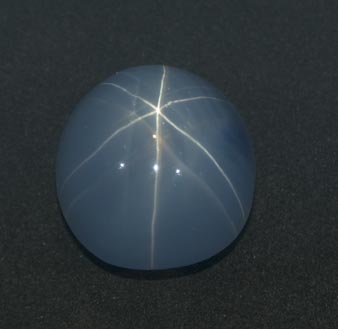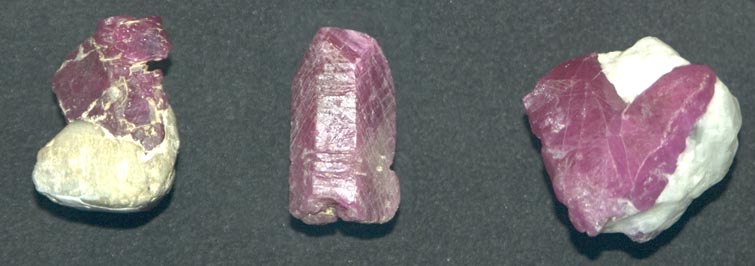
Crystal system: Trigonal (often
appears hexagonal in outline)
Chemical Formula/composition: Al2O3
Crystal habit: elongate hexagonal
prisms and hexagonal plates
Hardness: 9 on Moh's scale (2nd
hardest gemstone; only diamond superior)
Specific gravity: 4.0
Luster: non-metallic
Toughness: Excellent
Cleavage: None; basal parting
Optics: Biaxial negative, Birefringence:
Low (0.008), Dispersion: Low (0.018) Strong pleochroism (color and intensity
changes vary with crystallographic direction): strongest color perpendicular
to c axis
Color: red = ruby, all other colors
referred to as sapphire, colorless, yellow, orange (Padparadscha), pink,
green, blue, brown, and black. Very poor quality corundum is sometime referred
to as emery (examples being emery cloth and paper used for sanding).
Other: Asterism; star rubies and
sapphire are highly prized.
Varieties: ruby, sapphire (many
colors), Padparadscha(orange)
Occurrence: Well-formed crystals
are found in primary deposits of metamorphic origin. Both contact and regional
metamorphism are possible events leading to corundum formation. The host
rock may be metamorphosed marble or other rocks that have been influenced
by aluminum-rich fluids during metamorphism. All types of corundum are
found in alluvial (stream) deposits. Because of its high specific gravity,
concentration is placers is common. The deposits of gem gravel account
for a lot of production.
Localities: Many. Ruby--Afghanistan,
Cambodia, Kenya, Myanmar (Burma), Pakistan, Sri Lanka, Tanzania, Thailand.
Sapphire- Australia, Cambodia, East Africa, Kashmir, Myanmar, Nigeria,
Sri Lanka, Thailand, USA. USA locations: North Carolina (Cowee Valley in
Macon County) and Montana (many locations)
Common simulants: Easily synthesized
by Verneuil method and also grown by flux methods
Synthetics: Synthetic gem quality
has been available for many years (starting in early 1900s).


The name ruby is derived from the Latin word "rubrum" meaning red. The best red and most valuable rubies are usually from Burma. Thai rubies tend to be violet red. Smaller numbers of rubies also come from Sri Lanka, Cambodia, Pakistan, India, and Tanzania. Sapphires come from similar localities and are also found in the USA in Montana.
Natural rubies are most desirable when colored a pigeon-blood red; but other stones such a spinel and garnet may have a very similar color (For instance, the Black Prince Ruby in the British Crown Jewels turned out to be a spinel). Study of the inclusions and physical properties may help to avoid confusion.
As the color of a ruby lightens, its name is changed to Pink Sapphire. Pink is a lighter shade of red; this name has been used since the 1800s and is well accepted.
Hence red stones must be carefully tested. The superior hardness of corundum is useful on uncut stones, and cut stones will typically have a good polish with no obvious scratching. A red stone with obvious scratches is probably actually a glass imitation.
When found in well-formed crystals, corundum often has either the shape of a six-sided prism with flat ends or a six-sided prism with pinnicoidal terminations (see pictures below). This can help to identify uncut stones, but gem-quality uncut material is seldom encountered. Because of strong pleochroism (change of color with direction) ruby and sapphire will look different colors in different directions. The stones are usually cut so that the table is at right angles to the the prism axis. Thus the color intensity and shade vary with color which is not true of garnets and spinels. Ruby tends to brighten in an intense light, unlike garnet and spinel.
Asterism, a star, occurs when inclusions such as rutile crystals align themselves with the crystal's symmetry. Thus they create a six-rayed star (asterisk) in corundum which is always cut with a cabochon to improve its appearance. The inclusions make the gems appear cloudy. Such crystals are prized, but usually the most valuable stones are transparent stones that do not have inclusions.
The best quality rubies and sapphires are always faceted. They should be transparent and clean of inclusions. Untreated large stones of high quality can sell for millions of dollars.
Because most stones have flaws, corundum is often enhanced. The most common treatment is heating (heated stones are not as valuable as unheated stones). Heating may allow natural coloring to become more even, may lighten a dark stone, or may actually cause a change of color. Different stones will respond differently to heating, and testing must be done to assure that the stone will not become inferior. Heating is well accepted in the gem industry unlike most other treatments.
Other treatments include oiling to hide cracks and add color along fractures, fracture filling, and coloring by diffusion. Diffusion can also be used to add a star to a stone. Diffusion can be vary deceptive and diffusion-treated stones must be stated as such. Diffusion is accomplished by heating a stone with the addition of chemical colorants such as beryllium, chromium, cobalt, etc. Often the stone is already faceted before heating and the diffusion treated stone's color enhancement is only skin deep.
Synthetic Corundum
Verneuil method--this method perfected by August Victor Lewis Verneuil uses flame fusion and powdered aluminum oxide ( Al2O3) to grow an elongate, rounded mass of corundum called a boule. Powdered Al2O3 and a coloring agent such as chromium are fused as they are dropped through a hydrogen and oxygen flame in a furnace. The corundum is grown on a seed or rod of synthetic corundum. Boules up to several hundred carats (about an inch wide by 3 inches long) are produced. These synthetic corundum's can have asterism induced in them as well. There are ways to identify corumdum made by this method (this might furnish a good topic for a paper or test question). Further information on this method and other ways of making synthetic corundum are available under synthetic stones.